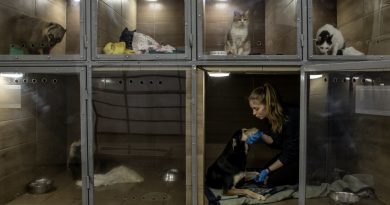CDC relaxes social distancing guidelines for schools, paving the way for more in-person instruction
Students no longer need to maintain a distance of six feet in classrooms according to Centers for Disease Control and Prevention guidelines announced Friday that reduced social distancing the recommendation to three feet.
The revised guidelines create more opportunities for schools to reopen for in-person learning as the six-foot rule had sharply limited how many students some schools could accommodate.
The agency said elementary school students can distance at three feet apart in classroom while wearing masks regardless of whether community transmission of COVID-19 is low, moderate, substantial or high.
Middle and high school students may also follow these recommendations if community transmission is low, moderate or substantial. However, they should remain distancing at six feet apart in community where transmission is high.
“Safe in-person instruction gives our kids access to critical social and mental health services that prepare them for the future, in addition to the education they need to succeed,” said CDC Director Dr. Rochelle Walensky. “These updated recommendations provide the evidence-based roadmap to help schools reopen safely, and remain open, for in-person instruction.”
The agency said recommendations are different between the age groups because older students are more likely to be exposed and spread the coronavirus than younger children.
While guidelines for students may have changed, the CDC said adults should still maintain six feet of distance between other adults or students at school buildings. The agency also still recommends social distancing at six feet in the following situations outside the classroom:
- In common areas, such as school lobbies and auditoriums.
- When masks can’t be worn, such as when eating.
- During activities with increased breathing such as singing, band practice or sports. The CDC also recommends these activities be moved outdoors or to well-ventilated spaces, if possible.
- In community settings outside the classroom.
Walensky said the CDC’s decision to update guidelines was based on three studies published Friday in the agency’s Morbidity and Mortality Weekly report that showed universal masking in elementary schools helped prevent transmission even if students aren’t able socially distance at six feet.
“Our studies have showed that when young children are masked, the difference of three feet is, in fact, safe,” she said during a White House briefing Friday. “For adults, we don’t have that evidence… so we’re continuing with the six feet guidance”
Questions over the amount of proper physical distancing in classrooms have weighed on school leaders for months.
In some cases, the previously recommended six feet of distance between students kept schools – especially those with space constraints – from bringing more children back to class. Or it kept them on hybrid schedules, with children only learning in school perhaps two days a week.
Dan Domenech, executive director of AASA, a national superintendents group, said most schools only have space to bring back half of their students at a time with the six-foot rule. Moving to three feet could allow about 75% at a time, he said.
“There are districts that have been doing three feet for quite some time without experiencing any greater amount of infection,” he said.
In January, the American Academy of Pediatrics had recommended that student desks could be placed three feet apart, even if six feet was ideal. The organization said at the time that if spacing reduces the amount of time children are present in school, “harm may outweigh potential benefits.”
Experts in child development say remote school, reduced socialization and increased screen time can negatively impact students, especially low-income kids who don’t have supportive caregivers or access to technology at home.
New evidence that it may be safe for schools to seat students 3 feet apart — half of the previous recommended distance — could offer a way to return more of the nation's children to classrooms with limited space. But teachers and parents are concerned. (March 16)
AP Domestic
However, the American Federation of Teachers is apprehensive about the guideline change. President Randi Weingarten hopes to end remote and hybrid learning soon, but fears the decision to change CDC guidelines was driven by a lack of physical space in classrooms instead of hard science.
“Until today, the literature on reducing distancing has been inconclusive at best and misleading at worst,” she said in a statement to USA TODAY. “We will reserve judgement until we review them, especially as they apply in districts with high community spread and older buildings with ventilation challenges.”
However, she praised the progress that has been made to ensure schools are safe as the latest data show approximately 80% of schools are offering some type of in-person instruction.
The $1.9 trillion COVID-19 relief package included $122 billion for K-12 schools to help pay for protective equipment, building improvements, additional staffing, more Wi-Fi hotspots and additional learning opportunities. It also included $10 million to help schools expand COVID-19 testing for students, teachers and staff.
“Let’s start working now to tackle the education, well-being and mitigation strategies needed to help schools reopen in the fall in a way that’s as close as ‘normal’ as possible, to help kids thrive,” Weingarten said. “Our families and children deserve nothing less.”
Contributing: Erin Richards, USA TODAY; Associated Press. Follow Adrianna Rodriguez on Twitter: @AdriannaUSAT.
Health and patient safety coverage at USA TODAY is made possible in part by a grant from the Masimo Foundation for Ethics, Innovation and Competition in Healthcare. The Masimo Foundation does not provide editorial input.
Source: Read Full Article


